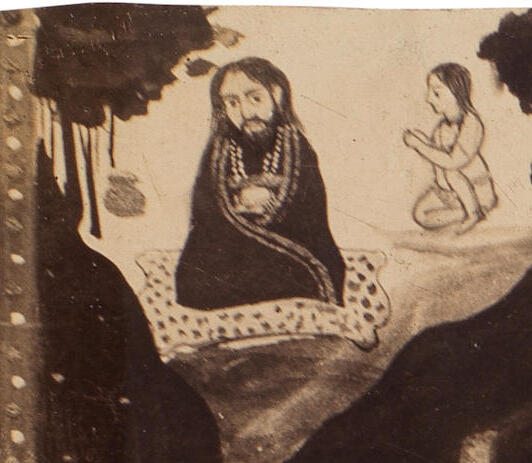Discover Savan Mall, nephew of Guru Amar Das, who procured timber for Goindval's expansion and spread Sikh teachings in the hills. Learn more about his journey.
BHIM CHAND, ruler of Kahlur (Bilaspur), a princely state in the Sivaliks, from 1665-92. The family claimed descent from Chandel Rajputs of Bundelkhand. Bhim Chand`s father, Dip Chand, was a tributary of the Mughals and he was allowed to exercise nominal authority over twenty-two states in the hills including Kulu, Karigra, Mandi, Suket and Chamba. Till the accession of Bhim Chand to the gaddfin 1665, the rulers of Kahlur had maintained amicable relations with the Gurus. In 1635, Guru Hargobind had retired to Kiratpur, a town founded by his son, Baba Gurditta, on the base of the Kahlur mount.
Explore the dynamic relations between Sikhs and hill states from Guru Nanak's time to Maharaja Ranjit Singh's reign, highlighting alliances and conflicts.
BIR GURU, by Rabindranath Tagore, is a life sketch in Bengali of Guru Gobind Singh (1666-1708), the last of the Ten Gurus of the Sikh faith, emphasizing especially how he had prepared Sikhs to stand up to oppression and injustice. This is Tagore`s first writing on Guru Gobind Singh published in 1885 in the Sraban July-August issue of the Balak. The poet was then in his early twenties. Though no reference is made in the text to any earlier work on the Sikhs, Tagore (1861-1941) seems to have been familiar with the writings of Malcolm (Sketch of the Sikhs), McGregor (History of the Sikhs) and Cunningham (A History of the Sikhs).
Discover Sukhdev, the daring ruler of Jasrota, who fought alongside Guru Gobind Singh against Mughal forces in 1691. Learn about his heroic legacy.
BUDDHU SHAH, PIR (1647-1704), a Muslim divine whose real name was Badr udDIn and who was an admirer of Guru Gobind Singh, was born on 13 June 1647 in a prosperous Sayyid family of Sadhaura, in present day Ambala district of Haryana. Because of his simplicity and silent nature during his early childhood he was given the nickname of Buddhu (lit. simpleton) which stuck to him permanently. He was married at the age of 18 to a pious lady, Nasirari, who was the sister of Said Khan, later a high ranking officer in the Mughal army.
Explore the captivating story of Wali Qandhari and Guru Nanak at Panja Sahib, Pakistan - a revered shrine with unmatched historical and spiritual significance!
Discover Castle Hill in Mussoorie, once home to Maharaja Duleep Singh. Explore its rich history, architecture, and stunning Himalayan views.
DESA SINGH MAJITHIA (1768-1832), an army general and civil administrator in Sikh times, was the son of Naudh Singh, a feudal retainer under Amar Singh Bagga of the Kanhaiya misl. When Naudh Singh died in 1788, Desa Singh succeeded to the family estates. He served Buddh Singh Bagga, successor of Amar Singh Bagga, for a number of years before joining Ranjit Singh`s army. In 1804, Desa Singh was made a commander of 400 sowars. He served the Maharaja in many of his early campaigns.
DIAL, RAJA (d. 1691), of Bijharval who allied himself with Alif Khan, the Mughal commander, despatched by Miari Khan, the viceroy of Jammu, to exact tribute from the hill chieftains. The hill princes sought Guru Gobind Singh`s help and a battle took place on 20 March 1691 at Nadaun on the left bank of the River Beas, 32 km southeast of Kangra. According to Bhai Santokh Singh, Sri Gur Pratap Suraj Granth, Raja Dial fell to a shot from Guru Gobind Singh.





